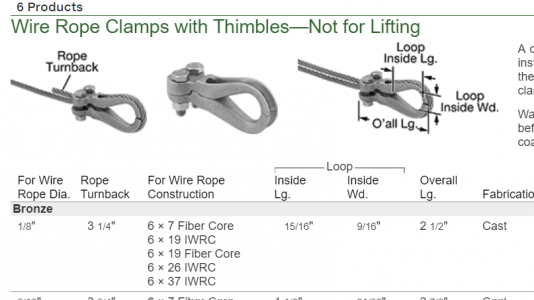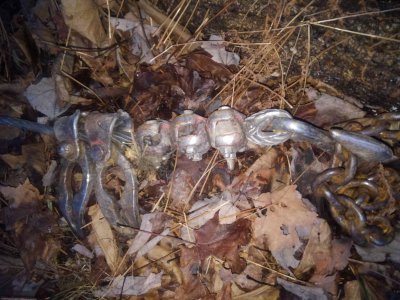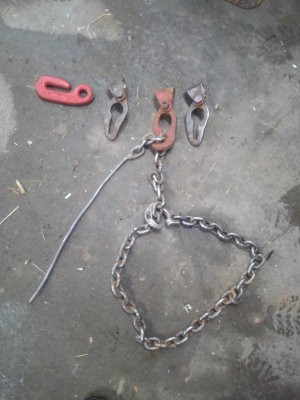Logging is a part time hobby for me. The cable does take a beating. After awhile it starts getting frayed near the ends, when it gets bad enough you can cut off 10 feet or so, then next time swap the cable end for end, eventually it gets short enough. That combined clamp and thimble looks like a great idea, only "rated" for 4000 lb on a 9000 winch
A 9000 pound winch is only 9000 pounds on the first wrap. At the top wrap, with the specified size and type of cable, the actual pull will just about exactly match the specified wire rope strength. You'd have to do the geometry on your drum to see where it's at. but yeah... And add to that, you have a winch that was "probably" spec'ed by the equipment manufacturer, and logging winches tend to use cables WAY larger than other industries, because they know full well that you're going to (on purpose, by design) do just about everything wrong when it comes to caring for that cable. So they're oversized compared to standard. Not for the strength, but because they will typically be wet, filled with dirt, probably get some kinks here and there, etc.
Logging is a part time hobby for me. The cable does take a beating. After awhile it starts getting frayed near the ends, when it gets bad enough you can cut off 10 feet or so, then next time swap the cable end for end, eventually it gets short enough. That combined clamp and thimble looks like a great idea, only "rated" for 4000 lb on a 9000 winch
First and foremost, I'm afraid this post is going to come off with the wrong intention, so let me be clear up front. I am NOT trying to push you here... My only to explain I would suggest that as a possiblility with such a great disagreement in the numbers. If you're not 100 percent comfortable with what I'm saying.... This is industrial stuff, made with lots of weight, lots of force, and lots of potential energy stored at any given time... PLEASE DO NOT EVER take my advice (or anybody's advice) unless you're completely comfortable with it. Forget getting killed, even if you've got to crouch and duck because you're worried about an incident happening that never actually happens, life is too short to live it that way.
First, is experience. We use those clamps on 3/8 "standard" 7X19 IWRC ropes, on 8,000 to 10,000 poundd hydraulic winches. Our winches (and any that I have encountered on the repair side as well) are all rated in pull strength on the bottom wrap. With the drum full, our winches ALL have a pull rating about equal to a specific cable type, construction, and material that will be called out on the data tag, which is WAY less than the winches capacity. We've also used them on the larg(er) "medium duty" wrecker, which uses 1/2 "standard" 7X19 IWRC on 12,000 pound winches. The mismatch of capacity there is not a mistake, it's just how the ratings and matchings are done. And as I said, those particular clamps are not the weak link when we do it.
So that's experience. Here's my take on the numbers. If you take a "standard" wire rope break strength, which is half inch in your case, you're looking at 5:1 for the workinig load. That's solid into overhead lifting territory. (Which these are NOT for....). Then knock off their derate percentage for the repair, and that's about their rating. If you have an unrated wire rope, the absolute minimum it can be, the amount you assign to an unmarked rope of unknown geneology, you're still rock solid at 4:1 doing it that way. Newco Manufacturing, (who used to be independant, then was owned by Muncie, but I think has recently been sold?) has never published any ultimate or breaking loads on these clamps. They are a reputable company, US enough that they CAN be reached by liability lawyars, and this is a "field installed" fitting. So you would expect them to rate concervatively. And I'm sure you know of and may have experienced some of the well rated repair commponents and hardware that fail at a third of what they're rated for... So I use those numbers to "reverse engineer" the missing specifications, apply common sense, and validate that with "what they really do in the wild". So long as my reverse engineering is consistant with what I find by doing the same math to a similar (quality) product, AND so long as I find real world performance that matches this, and ESPECIALLY if I've been using something for long enough to have a couple of real world failures? What did the cowboys do to this to make it fail? How does that compare to other options? How does that compare to an original, manufactured product with a factory eye at the end... If the product does as well or better, I'm good.
Osha and the insurance company could give two (craps) about my observations of how the abuse falures compare to other products, however both of those entities are quite satisfied with these repairs. Osha doesn't give a damn, so long as it's marked. The insurance company doesn't call it "temporary", they let me keep them. They do that with crosby clips, I'm allowed to use those, but those are to get you home, and have to be updated to something perminant "as soon as practicable", or "temporary until a repair can be affected" or something along those lines.
And two more real world factors that I always consider-
Because winches are rated the way they are and cables selected the way they are, the onus is ALWAYS on the operator. You can never "rate" yourself into a point of not paying attentioin to what you're doing.
And swaged rope- Because even though it's a half an inch diameter, what you have a 9/16 inch rope there (there's at least one company doing 5/8, but most are for sure 9/16), save for a few specialized items, you will NEVER find hardware that's properly rated for that rope. So you're gonna have to live with that. That's most of the reason I said I'd consider unspooling it and using a sliding hook, is simply that that will allow a suitable bend radius when the hook pulls on the stop, so you need not cut it. On the other hand, I do not disagree with your counterpoint here.
And I'm going to repeat myself again- I do NOT want to "talk you into this" or "talk you out of that". I'm just was offering another option that not many are aware of. I did that in the first post. My ONLY purpose in this follow up is to answer what I think is a VERY fair question about weight ratings that don't seem to jive.
I see that you're up to a fix that might solve two problems... If you've got a winch, that will physically accept a rope with a 2:1 (or better) margin over the winch, on it's lowest wrap, and you can get something on there (without having to carry it out to a shop to get it done)... If you can pull it off, that's gonna be a win on every level.






